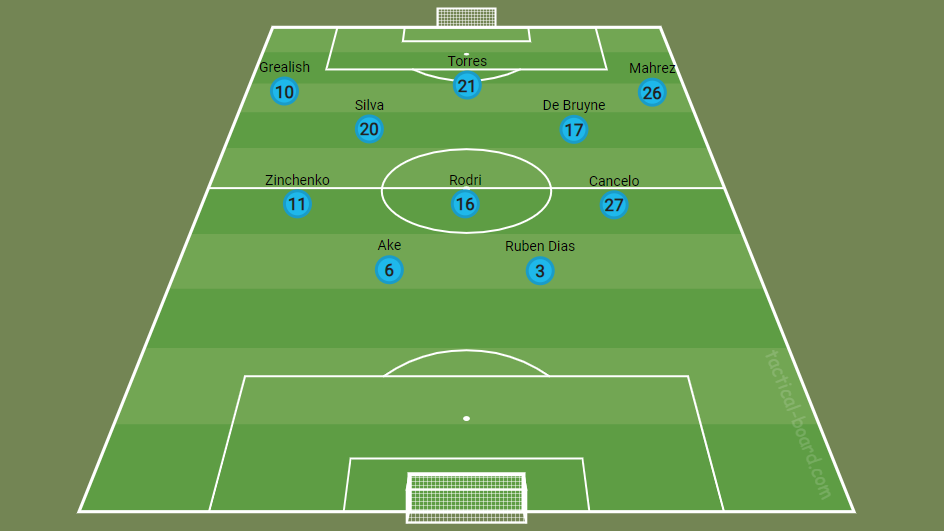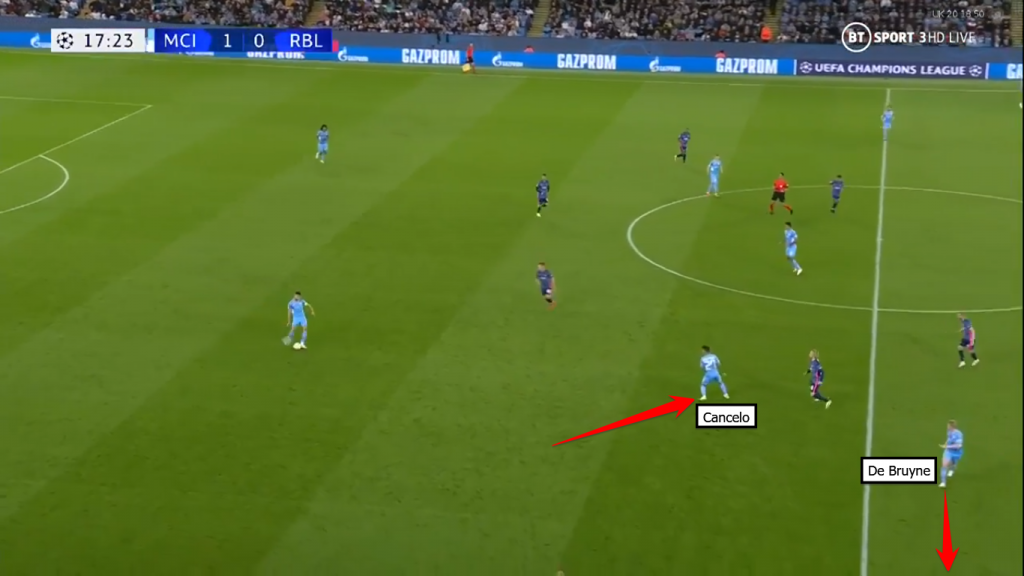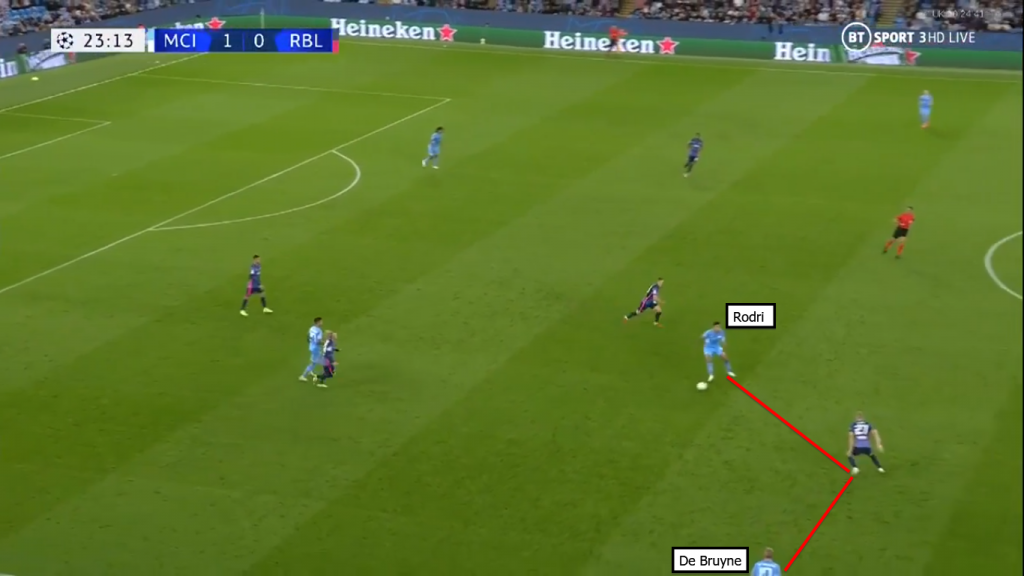Manchester City plays with 4-3-3 line up. In set attacks, the formation changes with like a 2-3-5. Full backs take position centrally and help defensive midfielder about making game. Right and left centre midfielders use half-spaces and take position closer to forward players. Right and left wingers take position closer to touchlines.
When they try to make game, full backs take position in 4 different positions. They try to take position coordinately with centre midfielder who takes position in the same wing and with winger who takes position in the same wing. Full backs could take position closer to the defense line and be the 3rd stopper in the half-space, closer to the defense line in the wing, closer to defensive midfielder in midfield from half-space or centre, closer to wing from midfield. Both could take position at the same time with the same positioning or they could take position in two different types at the same time.
Manchester City usually tries to make game from the triangle between full backs, centre midfielders and wingers. The defensive midfielder, stoppers or centre forward could help them about making game but these 3 players are enough to make game. Full backs, centre midfielders and wingers try to take position diagonally each other and because of that, they don’t have a regular positioning. Two players who take position in the same vertical space and make connection between them in a vertical space (like full back and centre midfielder or centre midfielder and winger) take position diagonally between each other. For example, if left back takes position in left half-space, left centre midfielder tries to take position in left wing and left winger tries to take position in left half-space. So the connection between left back and left centre midfielder and between left centre midfielder and left winger becomes diagonal. I will explain these styles of positioning with more details future in this article.

A lot of times, to create space for wingers in wings, right or left centre midfielder (who takes position in the same wing with winger) pulls the opponent’s full back to inside and winger can be free in the wing.
In this situation, Manchester City try to make game against Leipzig’s 4-2-3-1. As you see, Zinchenko takes position in centre, Grealish takes position in wing and Silva takes position in half-space. Zinchenko could pull the opponent’s right winger to himself because before Ake took the ball from Ruben Dias, Zinchenko was in half-space and right winger was marking him. When he moved to centre, right winger kept marking him.
Silva matches with the opponent’s right back in half-space and pulls him to inside. So Grealish can be free in the wing. The opponent’s right back can’t close to Grealish. Normally, the opponent’s right defensive midfielder matches with Silva automatically. But because Leipzig try to meet Manchester City with pressing in midfield’s front, right defensive midfielder stays close to Leipzig’s forwards to support pressing. So because of that, when Silva closed to forward, he couldn’t follow Silva and the opponent’s right back had to close to Silva.
Grealish closes to midfield from wing to take the ball. He is free and nobody marks him. The opponent’s right winger can’t cut the connection between Ake and Grealish because when he moved to centre with Zinchenko, Grealish remained out of his visual angle. So he can’t see Grealish’s move. Grealish takes the ball from Ake. The opponent’s right back can’t close to Grealish quickly because he was marking Silva. Grealish couldn’t use his freedom effectively because nobody supported him from centre to be a pass option and he passed back to Ake. But they used spaces effectively.

As I said before in this article, because Leipzig tries to meet Manchester City with pressing, the opponent’s defensive midfielders can’t mark De Bruyne and Silva 1 by 1. To support forwards about pressing, they take position closer to forward and this time, Silva and De Bruyne remain at their back.
In this situation, to help making game, De Bruyne and Silva close to midfield. This time, the opponent’s defensive midfielders can match with Silva and De Bruyne 1 by 1 because now they are not in the opponent’s defensive midfielders’ behind. And now, also the opponent’s full backs can match with Grealish and Mahrez 1 by 1. So it seems this positioning worked for Leipzig. But Manchester City could break Leipzig’s pressing and make game from De Bruyne.
In this situation, Ruben Dias takes the ball from Ederson. Both Cancelo and De Bruyne are in the half-space. The opponent’s left winger matches with Cancelo and left defensive midfielder matches with De Bruyne.
When Cancelo moves diagonal to centre little bit, he pulls the opponent’s right winger too. De Bruyne closes to wing to take the ball from Ruben Dias and the opponent’s left defensive midfielder doesn’t follow him. So Ruben Dias passes to De Bruyne, De Bruyne has enough time and space to look at his pass options before the opponent’s left winger covers him and he tries to pass the ball to Torres’ runway.
Cancelo could pull the opponent’s right winger because he moved, he didn’t stay. Actually, the opponent’s right winger saw De Bruyne’s movement but he couldn’t shift to De Bruyne. Because when Cancelo moved diagonal to centre, he became in a more central and forward space. So Cancelo’s new situation was a bigger threat than Cancelo’s previous situation for the opponent’s left winger. And because both Cancelo and De Bruyne were in a movement, he couldn’t focus on two different movements at the same time (because he is a human). So because he was already matching with Cancelo, he couldn’t close to De Bruyne. Also, the opponent’s left defensive midfielder didn’t shift to wing because now, De Bruyne was not in his marking area.

As I said before, when Manchester City tries to make game, 3 players are enough to make game but also, sometimes stoppers, defensive midfielder or centre forward helps making game and be the 4th player. And when one of these players is the 4th player, with productive movements, they can be more effective. And as I said before, usually these 3 or 4 players try to take position diagonally with each other.
In this situation, Ruben Dias has the ball. As you see, the opponent’s left winger is not taking position closer to Cancelo. Because he was covering De Bruyne with shadow marking. And because De Bruyne is in half-space, he is a threat for left winger too. And because for now De Bruyne is taking position more centrally than Cancelo, covering De Bruyne is more important for him.
Ruben Dias is passing to Cancelo. When the ball goes to Cancelo, Rodri starts to close to Cancelo and De Bruyne starts to close to wing to be a pass option for Cancelo. When Cancelo has the ball, he has enough time to do something with the ball because left winger couldn’t cover him quickly. Because he was covering De Bruyne with shadow marking before.

And Cancelo is passing to Rodri. The opponent’s offensive midfielder is matching with Rodri but because Rodri is taking position closer to Cancelo than him, Rodri can take the ball before him. And also offensive midfielder kept away from Rodri at the last time and it worked for Rodri.
When the ball was going to Rodri, now De Bruyne was taking position in wing. And De Bruyne pulled the opponent’s left defensive midfielder to wing too. But when Rodri has the ball, the opponent’s left defensive midfielder is starting to close to Rodri. But because he was closing to wing to cover De Bruyne, he can’t close to Rodri quickly. He has to change his running direction and then go for covering Rodri but it is a big waste of time. So he can’t cover both Rodri and De Bruyne well and Rodri can pass to De Bruyne comfortably.
And the other important factor which helped to De Bruyne about taking the ball from Rodri was, the opponent’s left defensive midfielder didn’t take position to cut the connection between Rodri and De Bruyne. But also he didn’t press to Rodri too. He took position in their’s middle, little bit back. It means, Rodri could pass to De Bruyne comfortably but also Rodri couldn’t move with the ball and play more directly. And also it means, De Bruyne could take the ball from Rodri comfortably because left defensive midfielder couldn’t cut the connection but also it means, when De Bruyne took the ball, left defensive midfielder could not let De Bruyne move forward with the ball free.
So left defensive midfielder’s positioning didn’t let De Bruyne or Rodri to be completely free. They had enough time to do something with the ball but they were not completely free. He had to do that because offensive midfielder couldn’t take position closer to Rodri. So left defensive midfielder had to try to cover Rodri and De Bruyne at the same time.

If they don’t take position diagonally with each other, their effectiveness becomes less.
For example, in this situation, Manchester City try to make game against Leicester City’s 4-2-2-2. Laporte passes to Grealish. He couldn’t pass to Silva because the opponent’s right winger could cut the connection between Laporte and Silva.
When the ball started to go to Grealish, the opponent’s right back started to close to Grealish, Silva started to close to wing and the opponent’s right stopper started to close to Silva.
So when Grealish took the ball, now Silva was in the wing. Grealish couldn’t pass to Silva because the connection between Silva and Grealish was vertical, not diagonal. And vertical direction’s problem is, it doesn’t change direction horizontally. It works for the defending team because defenders don’t need to change direction horizontally too. And also Grealish couldn’t pass right back with dribbling because right back was focusing on covering Grealish.
So in this situation, at the same time, the opponent’s right back blocked Grealish’s passing to Silva and also prevented Grealish’s passing right back with dribbling.
To explain diagonal positining’s importance better, let’s compare what would happen if Silva would be in half-space instead in wing and Grealish would be able to pass to Silva diagonal. This time, right back couldn’t cut the passing connection and stop defending Grealish at the same time. Because if he stayed at Grealish’s front like the first situation, this time Silva could take the ball because right back couldn’t cut the connection between Silva and Grealish.
If right back tried to cut the connection, this time he would give more space to Grealish to keep going from wing with the ball and Grealish could move from left with the ball comfortably.
But right back could make things difficult for Grealish and Silva either. If he took position diagonally against Grealish, he could cut the connection and stop Grealish’s movement from left with the ball at the same time. But because he couldn’t see Silva’s movement, if Silva could accord his position to connection between Grealish and him, in the end, Silva could take the ball from Grealish. So right back could make Grealish’s and Silva’s effectiveness become less but in the end, they could make game.
So, in the match situation, right back could cut the connection between Silva and Grealish. Rodri would close to Grealish for helping but he didn’t close enough to Grealish and also the opponent’s right centre midfielder took position closer to him.

